


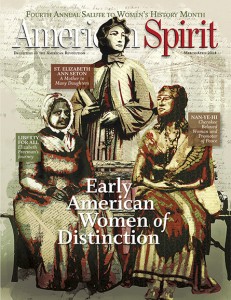 For four years, American Spirit* has dedicated its March/April issue to Women’s History Month. It’s a particularly enjoyable issue to write, edit and design in partnership with the Daughters of the American Revolution since it gives us a chance to find and promote little-known stories of fascinating women of early America.
For four years, American Spirit* has dedicated its March/April issue to Women’s History Month. It’s a particularly enjoyable issue to write, edit and design in partnership with the Daughters of the American Revolution since it gives us a chance to find and promote little-known stories of fascinating women of early America.
One of those women is a Cherokee “Beloved Woman” named Nan-ye-hi, an influential leader and peacekeeper during a time of great upheaval in the Cherokee Nation. Despite my living in Tennessee–her home and that of her ancestors–for the past 10 years, I had never even heard of Nan-ye-hi until the Nancy Ward DAR Chapter (named after her English name) suggested researching her life for this issue. It was a privilege to share that research with readers.
Our cover was designed to highlight Nan-ye-hi and two of the other diverse and distinguished women featured in this issue. Illustrator Antonio Rodrigues used organic shapes and earthy colors to illuminate Elizabeth Freeman, the former slave who helped abolish slavery in Massachusetts, St. Elizabeth Ann Seton, a pioneer in Catholic education who became the first U.S. citizen to be canonized, and Nan-ye-hi. The subtle background script that fleshes out the illustrations underscores one of American Spirit’s goals: to faithfully record these early American women’s remarkable stories and convey their importance to modern readers.
Another feature is excerpted from Nancy Rubin Stuart’s book, Defiant Brides: The Untold Story of Two Revolutionary-Era Women and the Radical Men They Married. Stuart details the moments that Lucy Flucker Knox and Peggy Shippen Arnold met their Revolutionary husbands Henry Knox and Benedict Arnold, and hints at ways the women’s initially parallel lives eventually diverged.
It’s Mardi Gras season, so it’s fitting that we travel to Louisiana for two stories: Our Historic Homes department visits Laura Plantation, a French Creole sugar plantation that was run by several strong-willed women in the 19th century, and Spirited Adventures checks in on Natchitoches, the oldest permanent settlement in the Louisiana Purchase.
*For more than a decade, Hammock has been honored to assist the National Society Daughters of the American Revolution in publishing their award-winning magazine. Anyone can subscribe here.
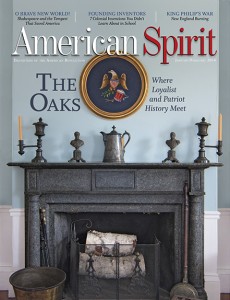 Every issue of American Spirit* invites readers to learn more about a historic home–and its owners–particularly those with connections to the Colonial or Early American period. Gracing the January/February cover is The Oaks, a Worcester, Mass., home finished at the end of the Revolution by Judge Timothy Paine and later occupied by his son, Dr. William Paine. Both Paines were Tories, but, ironically, the home is now owned and preserved by the Colonel Timothy Bigelow DAR Chapter, named for the Revolutionary minuteman, prisoner of war and military commander.
Every issue of American Spirit* invites readers to learn more about a historic home–and its owners–particularly those with connections to the Colonial or Early American period. Gracing the January/February cover is The Oaks, a Worcester, Mass., home finished at the end of the Revolution by Judge Timothy Paine and later occupied by his son, Dr. William Paine. Both Paines were Tories, but, ironically, the home is now owned and preserved by the Colonel Timothy Bigelow DAR Chapter, named for the Revolutionary minuteman, prisoner of war and military commander.
Another feature honors the French-born Patriot Comte de Rochambeau. He forged an effective partnership with George Washington and played an integral role in the British defeat at the Siege of Yorktown.
We delve into law and order, early-American-style, for a feature on Virginia statesman George Wythe. We investigate the mysterious circumstances of this Patriot’s painful death, probably at the hands of his ne’er-do-well grandnephew.
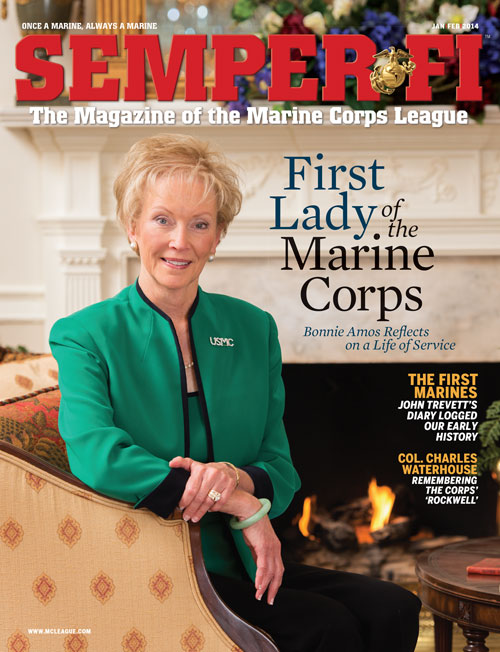 In the Januaru-February issue of Semper Fi, the magazine of the Marine Corps League, we are proud to present an exclusive, in-depth interview with Bonnie Amos, wife of the 35th USMC Commandant, General James F. Amos.
In the Januaru-February issue of Semper Fi, the magazine of the Marine Corps League, we are proud to present an exclusive, in-depth interview with Bonnie Amos, wife of the 35th USMC Commandant, General James F. Amos.
Over more than 40 years of marriage, Mrs. Amos has seen virtually every aspect of Marine life. This gracious and soft-spoken woman often dons a helmet and body armor to accompany her husband to the war zones to bring a touch of home to Marines at the point of the spear.
Her work with injured Marines helped bring about the standing up of the Wounded Warrior Regiment. Together, she and General Amos care about, watch over and work for the betterment of Marines and their families. Her story will inspire and move you.
Also in the January-February issue, we travel back to the Corps’ early days as recorded in the diary of Continental Marine John Trevett. Serving under our first Commandant, Capt. Samuel Nicholas, Trevett took part in the Corps’ very first amphibious operations.
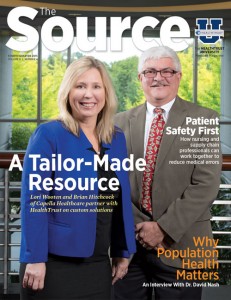 Population health was foremost on our minds as we prepared the Q4 issue of The Source, the magazine we help HealthTrust publish for healthcare supply chain professionals. Healthcare systems and physicians groups are developing new programs aimed at population health management, a systematic approach to addressing the preventive, high-risk and chronic care needs of patients, with a goal of minimizing costly interventions like emergency room visits, hospitalizations and readmissions. We interview Dr. David Nash, of the Jefferson School of Population Health in Philadelphia, on this healthcare paradigm shift. As the founding dean of the first designated school of population health in the country, Nash is considered one of the leading experts in the field.
Population health was foremost on our minds as we prepared the Q4 issue of The Source, the magazine we help HealthTrust publish for healthcare supply chain professionals. Healthcare systems and physicians groups are developing new programs aimed at population health management, a systematic approach to addressing the preventive, high-risk and chronic care needs of patients, with a goal of minimizing costly interventions like emergency room visits, hospitalizations and readmissions. We interview Dr. David Nash, of the Jefferson School of Population Health in Philadelphia, on this healthcare paradigm shift. As the founding dean of the first designated school of population health in the country, Nash is considered one of the leading experts in the field.
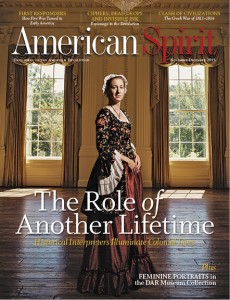
American Spirit* visited the American Village, a history and civics education center in Montevallo, Ala., for our November/December 2013 cover story profiling historical interpreters. (This editor grew up less than a mile away from the American Village, and it’s her family’s favorite spot for Fourth of July fireworks and other patriotic events.) The American Village re-enactors and others spotlighted in our story exhibit an extraordinary commitment to historical detail. That commitment to authenticity is best expressed by this quote from Patricia Bridgman, who plays Abigail Adams at Adams National Historical Park in Quincy, Mass., and at the Abigail Adams birthplace in Weymouth, Mass.
“I sweep my bangs up into a pompadour, eschew makeup, lace myself into stays, don a bum roll [a support, such as a hoop or pillow, worn under a skirt], petticoats and gown, along with silk stockings and reproduction shoes, and I’m ready to go,” Ms. Bridgman says. “The one question all re-enactors get is, ‘Aren’t you hot in that?’ The 21st-century answer is, ‘Damn straight,’ but Abigail says, ‘I am well accustomed to it, madam.’”
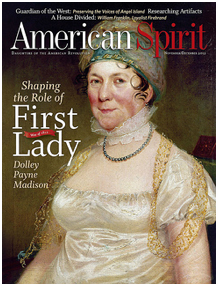 Here at Hammock we tend to subscribe to Natalie Portman’s philosophy that, “Awards are so unnecessary because [we] think we get so much out of our work just by doing it. The work is a reward in itself.” But that’s never stopped us from entering competitions or spreading the news of our success when we receive an award.
Here at Hammock we tend to subscribe to Natalie Portman’s philosophy that, “Awards are so unnecessary because [we] think we get so much out of our work just by doing it. The work is a reward in itself.” But that’s never stopped us from entering competitions or spreading the news of our success when we receive an award.
We recently learned that work we’ve done for clients received a total of five APEX Awards for Publication Excellence this year, including yet another Grand Award for American Spirit, the member magazine of the National Society Daughters of the American Revolution.
Jeff Cornwall, Belmont University entrepreneurship professor and longtime blogger (The Entrepreneurial Mind), recently invited Rex Hammock to appear on the video version of his blog — a show produced by the Nashville-based web video network, Talkapolis. In the 10 minute episode, Rex explains the customer media and content focus of Hammock Inc. — and our role in the context of today’s marketing landscape.



The companies that really know how to use customer media content—to create and deepen relationships with customers, not just to fulfill some checklist of sales and marketing materials—have a few things in common.
From our work and research, here are 10 traits of companies setting the benchmark for using customer media and content that works:
In the current Idea Email, we explore ten traits displayed by companies that use customer media and content that works to help customers discover their products and to build long term relationships with those who become buyers and users.
Here are six companies we believe are demonstrating some of those traits.